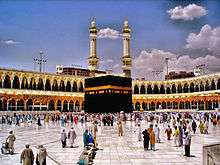Arabs
| العرب | |
|---|---|
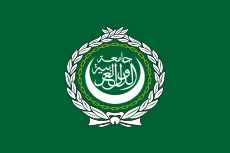 Flag of the Arab League | |
| Total population | |
| c. 430 – c. 450 million[1] | |
| Regions with significant populations | |
|
| |
| Significant Arab diaspora in: | |
| 12,000,000[3] | |
| 6,000,000[4] | |
| 4,500,000[5] | |
| 3,500,000[6] | |
| 1,800,000–2,600,000[7] | |
| 1,700,000[8] | |
| 1,600,000[9] | |
| 1,500,000[10] | |
| 1,500,000[11] | |
| 1,493,410[12] | |
| 1,000,000+[13] | |
| 1,100,000[14] | |
| 700,000[15] | |
| 500,000 [16] | |
| 350,000 [17] | |
| 480,000[18] | |
| 350,000[19] | |
| 150,000-200,000[20] | |
| Languages | |
| Arabic | |
| Religion | |
| Predominantly Islam (Sunni; also Shia, Ibadi); minority Christianity, Druze, Bahá'í Faith, other religions,[21] religious humanism[22][23] | |
| Related ethnic groups | |
| Other Afroasiatic-speaking peoples and Middle-Easterners | |
Arabs (Arabic: عرب, ‘arab) are a panethnicity whose native regions form the Arab world.[24] They primarily inhabit Western Asia, as well as parts of North Africa, the Horn of Africa, and East Africa.[25]
Before the spread of Islam, Arab referred to any of the largely nomadic Semitic people from the northern and central Arabian Peninsula.[26] In modern usage Arab refers to a heterogeneous collection of Arabic-speaking peoples in the Arab world. The ties that bind Arabs are ethnic, linguistic, cultural, and political,[27][28][29] with Arabized Arabs appearing to be predominantly descended from indigenous, pre-Arabian populations, though with some recent ancestry from the Arabian peninsula.[30][31]
Arabs primarily inhabit the 22 Arab states within the Arab League: Algeria, Bahrain, Comoros, Djibouti, Egypt, Iraq, Jordan, Kuwait, Lebanon, Libya, Mauritania, Morocco, Oman, Qatar, Palestine, Saudi Arabia, Somalia, Sudan, Syria, Tunisia, United Arab Emirates and Yemen. The Arab world stretches around 13 million km², from the Atlantic Ocean in the west to the Arabian Sea in the east, and from the Mediterranean Sea in the north to the Horn of Africa and the Indian Ocean in the southeast. Beyond the boundaries of the League of Arab States, Arabs can also be found in the diaspora.[32] In total, there are an estimated 450 million Arabs.[1] This makes them the world's second largest population group after the Han Chinese.
In the pre-Islamic era, most Arabs followed polytheistic religions, including Hubal, Wadd, Al-Lat, Manat, and Uzza. Some tribes had adopted Christianity or Judaism, and a few individuals, the hanifs, apparently observed monotheism.[33][34] Today, Arabs are mainly Muslim adherents, with sizeable Christian followers.[35] Arab Muslims primarily belong to the Sunni, Shiite, Ibadhite, Alawite, Druze and Ismaili denominations. Arab Christians generally follow one of the Eastern Christian Churches, such as the Maronite, Coptic Orthodox, Greek Orthodox, Greek Catholic, or Chaldean churches.[36]
Name
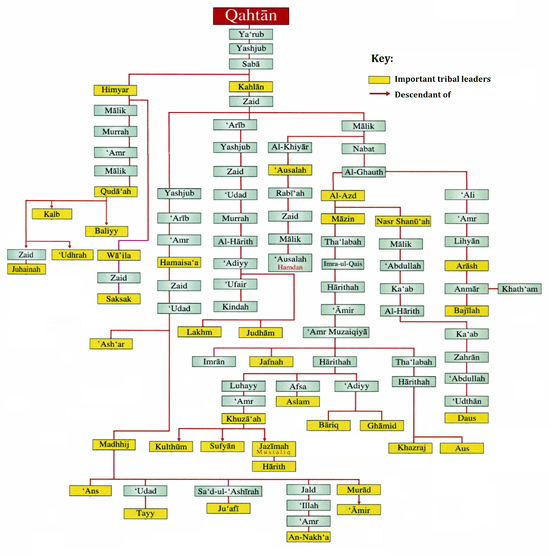
Originally, "Arabs" were synonymous with the tribes of Arabia, until the Arabization of people outside the Arabian peninsula, mostly during the Abassid era. Therefore, all uses of the word "Arab" before the sixth century, and most of those before the 13th century, refer specifically to Arabians. Later uses of the word "Arab" could refer to any individual whose familial ancestry corresponds to the wider linguistic and panethnic definitions of Arabs. The earliest documented use of the word "Arab" to refer to a people appears in the Kurkh Monoliths, an Akkadian language record of the ninth century BCE Assyrian conquest of Aram, which referred to Bedouins of the Arabian Peninsula under King Gindibu, who fought as part of a coalition opposed to Assyria.[37] Listed among the booty captured by the army of king Shalmaneser III of Assyria in the Battle of Qarqar are 1000 camels of "Gi-in-di-bu'u the ar-ba-a-a" or "[the man] Gindibu belonging to the arab (ar-ba-a-a being an adjectival nisba of the noun ʿarab[37]). The related word ʾaʿrāb is still used to refer to Bedouins today, in contrast to ʿarab which refers to Arabs in general.[38]
The oldest surviving indication of an Arab national identity is an inscription made in an archaic form of Arabic in 328 using the Nabataean alphabet, which refers to Imru' al-Qays ibn 'Amr as "King of all the Arabs".[39][40] Herodotus refers to the Arabs in the Sinai, southern Palestine, and the frankincense region, but inscriptions of Yemen start the use of the term 'Arab' only in the second century BC.[41]
The most popular Arab account holds that the word Arab came from an eponymous father called Ya'rub who was supposedly the first to speak Arabic. Abu Muhammad al-Hasan al-Hamdani had another view; he states that Arabs were called Gharab ("West") by Mesopotamians because Bedouins originally resided to the west of Mesopotamia; the term was then corrupted into Arab.

Yet another view is held by al-Masudi that the word Arabs was initially applied to the Ishmaelites of the "Arabah" valley.
In Biblical etymology, "Arab" (in Hebrew Arvi ) comes both from the desert origin of the Bedouins it originally described (Arava means wilderness). The root ʿ-r-b has several additional meanings in Semitic languages—including "west/sunset," "desert," "mingle," "mixed," "merchant," and "raven"—and are "comprehensible" with all of these having varying degrees of relevance to the emergence of the name. It is also possible that some forms were metathetical from ʿ-B-R "moving around" (Arabic ʿ-B-R "traverse"), and hence, it is alleged, "nomadic."
Identity
Arab identity is defined independently of religious identity, and pre-dates the spread of Islam, with historically attested Arab Christian kingdoms and Arab Jewish tribes. Today, however, most Arabs are Muslim,[42][43] with a minority adhering to other faiths, largely Christianity, but also Druze and Baha'i.
Arabs are generally Sunni, Shia or Sufi Muslims, but currently, 7.1 percent to 10 percent of Arabs are Arab Christians.[44] This figure includes only Christians whose primary community language is today a variety of Arabic, and who identify as Arab.
Arab ethnic identity does not include Christian, Jewish and other ethnic groups that retain non-Arabic languages and/or identities within the expanded Arab World. These include the Jews, Samaritans, Assyrian people of Iraq, north east Syria, north west Iran and south east Turkey, the Syriac Christians of western Syria, Armenians around the entire Near East, and Mandaeans in Iraq and Iran—though many of these peoples speak Arabic as a first or second language. In addition, Copts and Maronites espouse an ancient Egyptian and Phoenician identity respectively, rather than an Arab one.[45]
Additionally, a number of other indigenous peoples living within what is considered the Arab World are equally non-Arab, even if they are ethnic groups which predominantly consist of adherents of Islam. These include ethnic groups such as Berbers, Kurds, Turks, Persians/Iranians, Azeris, Yezidis, Circassians, Shabaks, Turcomans, Romani, Chechens, Kawliya, Mhallami. Nor does Arab include migrant groups resident in the Arab World, even if they are largely of the Muslim faith, including migrants from Sub-Saharan Africa, South Asia and Southeast Asia.
Today, the main unifying characteristic among Arabs is Arabic, a South Semitic language from the Afroasiatic language family. Modern Standard Arabic serves as the standardized and literary variety of Arabic used in writing, as well as in most formal speech, although it is not used in daily speech by the overwhelming majority of Arabs. Most Arabs who are functional in Modern Standard Arabic acquire it through education and use it solely for writing and formal settings. While various varieties of Arabic are spoken as vernaculars by each distinct Arab group, these varieties are often regarded as dialects rather than independent languages. Most of these dialects are mutually intelligible, although not all of them.
The Arabs are first mentioned in the mid-ninth century BCE as a tribal people dwelling in the central Arabian Peninsula subjugated by Upper Mesopotamia-based state of Assyria. The Arabs appear to have remained largely under the vassalage of the Neo-Assyrian Empire (911-605 BCE), and then the succeeding Neo-Babylonian Empire (605-539 BCE), Persian Achaemenid Empire (539-332 BCE), Greek Macedonian/Seleucid Empire and Parthian Empire.
Arab tribes, most notably the Ghassanids and Lakhmids begin to appear in the south Syrian deserts and southern Jordan from the mid 3rd century CE onwards, during the mid to later stages of the Roman Empire and Sasanian Empire. The Nabataeans of Jordan appear to have been an Aramaic speaking ethnic mix of Canaanites, Arameans and Arabs. Thus, although a more limited diffusion of Arab culture and language was felt in some areas by these migrant minority Arabs in pre-Islamic times through Arab Christian kingdoms and Arab Jewish tribes, it was only after the rise of Islam in the mid-7th century that Arab culture, people and language began their wholesale spread from the central Arabian Peninsula (including the south Syrian desert) through conquest and trade.
At the time of the early Muslim conquests of the seventh and eighth centuries, the population of Mesopotamia, the Levant and nearby regions was primarily Aramaic speakers with a minority such as Persians, Jews, Greeks, Armenians, Romans, Samaritans. Egypt was largely populated by natives of ancient Egyptian heritage with a Greek minority, the Maghreb by Carthaginians and Berbers as well as a small minority of Germanic peoples such as the Vandals and Visigoths ruling kingdoms.
Arab cultures went through a mixing process. Therefore, every Arab country has cultural specificities that form a cultural mix that incorporates local novelties acquired after arabization. However, all Arab countries do also share a common culture in arts (music, literature, poetry, calligraphy...), cultural products (handicrafts, carpets, henne, bronze carving...), social behavior, and relations (hospitality, codes of conduct among friends and family...), customs and superstitions, some dishes (shorba, mloukhia), traditional clothing, and architecture.

Non-Arab Muslims, who are about 80 percent of the world's Muslim population do not form part of the Arab world, but instead constitute what is the geographically larger, and more diverse, Muslim World.
In the USA, Arabs are classified as white by the U.S. Census, and have been since before 1977.[46][47][48]
Arabic, the main unifying feature among Arabs, is a Semitic language. During the early Muslim conquests, Arabic language, culture, and people spread across most of West Asia and North Africa,[49] resulting in the acculturation of their inhabitants as Arabs. Arabization, a culturo-linguistic shift, was often, though not always, in conjunction with Islamization, a religious shift.
With the rise of Islam in the seventh century, and as the language of the Qur'an, Arabic became the lingua franca of the Islamic world.[50] It was in this period that Arabic language and culture was widely disseminated with the early Islamic expansion, both through conquest and cultural contact.[51]
Arab culture and language, however, began a more limited diffusion before the Islamic Golden Age, first spreading in West Asia beginning in the second century as Arab Christians such as the Ghassanids, Lakhmids and Banu Judham began migrating north from Arabia into the Syrian Desert, south western Iraq and the Levant.[52][53]
In the modern era, defining who is an Arab is done on the grounds of one or more of the following two criteria:
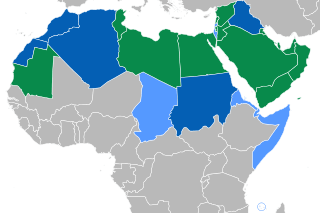
- Genealogical: someone who can trace his or her ancestry to the original inhabitants of the Arabian Peninsula and the Syrian Desert (tribes of Arabia). This was the definition used until medieval times, for example by Ibn Khaldun, but has decreased in importance over time, as a portion of those of Arab ancestry lost their links with their ancestors' motherland. In the modern era, however, DNA tests have at times proved reliable in identifying those of Arab genealogical descent. For example, it has been found that the frequency of the "Arab marker" Haplogroup J1 collapses suddenly at the borders of Arabic speaking countries.[54]
- Linguistic: someone whose first language, and by extension cultural expression, is Arabic, including any of its varieties. This definition covers more than 420 million people (2014 estimate). Certain groups that fulfill this criterion reject this definition on the basis of non-Arab ancestry; such an example may be seen in the way that Egyptians identified themselves in the early 20th century.[55][56]
The relative importance of these factors is estimated differently by different groups and frequently disputed. Some combine aspects of each definition, as done by Palestinian Habib Hassan Touma,[57] who defines an Arab "in the modern sense of the word", as "one who is a national of an Arab state, has command of the Arabic language, and possesses a fundamental knowledge of Arab tradition, that is, of the manners, customs, and political and social systems of the culture." Most people who consider themselves Arab do so based on the overlap of the political and linguistic definitions.
The Arab League, a regional organization of countries intended to encompass the Arab world, defines an Arab as:
An Arab is a person whose language is Arabic, who lives in an Arabic-speaking country, and who is in sympathy with the aspirations of the Arabic-speaking peoples.[58]
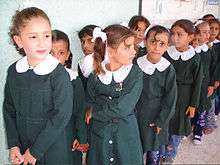
According to Sadek Jawad Sulaimanis the former Ambassador of Oman to the United States:
The Arabs are defined by their culture, not by race; and their culture is defined by its essential twin constituents of Arabism and Islam. To most of the Arabs, Islam is their indigenous religion; to all of the Arabs, Islam is their indigenous civilization. The Arab identity, as such, is a culturally defined identity, which means being Arab is being someone whose mother culture, or dominant culture, is Arabism. Beyond that, he or she might be of any ancestry, of any religion or philosophical persuasion, and a citizen of any country in the world. Being Arab does not contradict with being non-Muslim or non-Semitic or not being a citizen of an Arab state.[59]
The relation of ʿarab and ʾaʿrāb is complicated further by the notion of "lost Arabs" al-ʿArab al-ba'ida mentioned in the Qur'an as punished for their disbelief. All contemporary Arabs were considered as descended from two ancestors, Qahtan and Adnan.
Versteegh (1997) is uncertain whether to ascribe this distinction to the memory of a real difference of origin of the two groups, but it is certain that the difference was strongly felt in early Islamic times. Even in Islamic Spain there was enmity between the Qays of the northern and the Kalb of the southern group. The so-called Sabaean or Himyarite language described by Abū Muhammad al-Hasan al-Hamdānī (died 946) appears to be a special case of language contact between the two groups, an originally north Arabic dialect spoken in the south, and influenced by Old South Arabian.
During the early Muslim conquests of the 7th and 8th centuries, the Arabs forged the Rashidun and then Umayyad Caliphate, and later the Abbasid Caliphate, whose borders touched southern France in the west, China in the east, Anatolia in the north, and the Sudan in the south. This was one of the largest land empires in history. In much of this area, the Arabs spread Islam and Arab culture, science, and language through conversion and cultural assimilation.
Subgroups
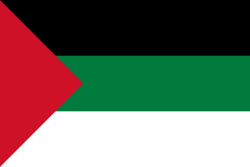
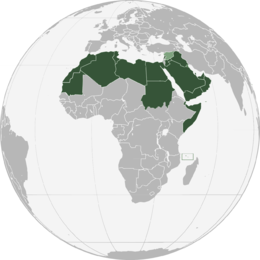
While Pan-Arabism and Arab nationalism subsume all Arabic-speaking populations under the notion of "Arabs", there are numerous sub-divisions, not all of which necessarily identify as ethnically Arab.
Arabians form a strict subset of the ethnolinguistic group of "Arabs" discussed here. The name of Arab historically was synonymous with Bedouin. In some parts of the Arab World, the term Arab may still carry connotations of being from the Arabian Peninsula, conflicting with the Pan-Arabist concept of ethnicity.
Arabians are most prevalent in the Arabian Peninsula, but are also found in large numbers in Mesopotamia (Arab tribes in Iraq), the Levant and Sinai (Negev Bedouin, Tarabin bedouin), as well as the Maghreb (Libya, South Tunisia and South Algeria) and the Sudan region.
Arabian Peninsula
Arabs in the narrow sense are the indigenous Arabians (who trace their roots back to the tribes of Arabia) and their immediate descendant groups in the Levant and North Africa. Within the people of the Arabian Peninsula, distinction is made between:
- Pure Arabs or Qahtanites (العرب العاربة) from Yemen, taken to be descended from Ya‘rub ibn Yashjub ibn Qahtan and further from either Ishmael or Hud.
- Arabized Arabs or Adnanites (العرب المستعربة), taken to be the descendants of Ishmael son of Abraham.
This traditional division of the Arabs of Arabia may have arisen at the time of the First Fitna. Of the Arabian tribes that interacted with Muhammad, the most prominent was the Quraysh. The Quraysh subclan, the Banu Hashim, was the clan of Muhammad. During the early Muslim conquests and the Islamic Golden Age, the political rulers of Islam were exclusively members of the Quraysh.
Iraq
The 150 Arab tribes in Iraq are grouped into federations (qabila), and divided into clans (fukhdh). The so-called Marsh Arabs of southern Iraq consist of numerous tribes, partly within the large al-Muntafiq tribal alliance.
Iran
Iranian Arabs form a 2% minority in Iran. The largest group are the Ahwazi Arabs, including Banu Ka'b, Bani Turuf and the Musha'sha'iyyah sect . Smaller groups are the Khamseh nomads in Fars Province and the Arabs in Khorasan.
The Levant
The Arabs of the Levant are traditionally divided into Qays and Yaman tribes. This tribal division is likewise taken to date to the Umayyad period. The Yemen trace their origin to South Arabia or Yemen; they include Banu Kalb, Kindah, Ghassanids, and Lakhmids.[60]
Since the 1834 Peasants' revolt in Palestine, the Arabic-speaking population of Palestine has shed its formerly tribal structure and emerged as the Palestinians, the same can be said about most of the inhabitants of the Levant who no longer determine their identity in tribal and clan lineages.
Nile Valley
_-_TIMEA.jpg)
The Arabic-speaking Bedouin of western Egypt and eastern Libya are traditionally divided into Saʿada and Murabtin, the Saʿada having higher social status. This may derive from a historical feudal system in which the Murabtin were vassals to the Saʿada.
In Sudan, there are numerous Arabic-speaking tribes, including the Shaigya, Ja'alin and Shukria, who are ancestrally related to the Nubians. These groups are collectively known as Sudanese Arabs. In addition, there are other Afroasiatic-speaking populations, such as Copts and Beja.
The medieval Arab slave trade in the Sudan drove a wedge between the Arabic-speaking groups and the indigenous Nilotic populations. Slavery substantially persists today along these lines.[61] It has contributed to ethnic conflict in the region, such as the Sudanese conflict in South Kordofan and Blue Nile, Northern Mali conflict, or the Boko Haram insurgency.
Maghreb
The Arabs of the Maghreb are descendants of Arabian tribes of Banu Hilal, the Banu Sulaym and the Maqil native of Middle East[62] and of other tribes native to Saudi Arabia, Yemen and Iraq. Arabs and Arabic-speakers inhabit plains and cities.
Outside of this region, haplogroup J-M304 has a presence in North Africa: Morocco (about 20%[63]), Algeria (about 35%[63]) and Tunisia (about 31%[64]).
Moroccan Arabs are 30% E-V65, 30% E-M81, 20% J-M304 and 7% E-V22[65],.[66]
The Banu Hilal spent almost a century in Egypt before moving to Libya, Tunisia and Algeria, and another century later some moves to Morocco, it is logical to think that they are mixed with inhabitants of Egypt and with Libya.[67]
Demographics
The total number of Arabic speakers living in the Arab nations is estimated at 366 million by the CIA Factbook (as of 2014). The estimated number of Arabs in countries outside the Arab League is estimated at 17.5 million, yielding a total of close to 384 million.
According to the International Organization for Migration, there are 13 million first-generation Arab migrants in the world, of which 5.8 million reside in Arab countries, yielding a total of about 7 million people in the Arab diaspora.
The populations of the Arab countries are comparatively young. "Over 40 percent of the region's population is under 15. Only 4 nations - Bahrain, Kuwait, UAE, and Qatar have an under 15 population less than 35 percent."[68]
Arab world and Israel
According to the Charter of the Arab League (also known as the Pact of the League of Arab States), the League of Arab States is composed of independent Arab states that are signatories to the Charter.[69]
The Arab world consists largely of populations that are Arabized in varying degrees.[70] Ethnically Arab populations are predominant in the Arab states of the Arabian peninsula. In the Levant, local populations mainly descend from the ancient Phoenicians and other early non-Arabic-speaking Semitic groups.[71] Populations of Hamitic origin form the majorities in the Arab states of North Africa and the Horn of Africa.[25] In Mauritania, native communities consist of peoples of Hamitic (Arabized Berber), Arab and West African descent. Sudan and Chad are likewise inhabited by ethnic groups of Nilotic, Arab and Hamitic extraction. In Comoros, populations are primarily of Bantu and Arab heritage.[45] Other, non-Arabized ethnic groups within the Arab world include Berbers, Toubou, Nubians, Jews, Kurds, Armenians and Druze.[70]
The table below shows the distribution of populations in the Arab world and Israel, as well as the official language(s) within the various Arab states.[45]
| Country | Population | Official language(s) | Notes |
|---|---|---|---|
| | 38,700,000[72] | Arabic co-official language with Berber | Ethnic groups according to the CIA: Arab-Berber 99%, European less than 1%. Nearly all Algerians are of Berber origin, but only a minority identify themselves as Berber (~15%). |
| | 1,314,089[73] | Arabic official language | Ethnic groups according to the CIA: Bahraini 46%, Asian 45.5%, other Arabs 4.7%, African 1.6%, European 1%, other 1.2% (includes Gulf Co-operative country nationals, North and South Americans, and Oceanians) (2010 est.) |
| | 13,670,084[74] | Arabic co-official language with French | Ethnic groups according to the CIA: Sara 27.7%, Arab 12.3%, Mayo-Kebbi 11.5%, Kanem-Bornou 9%, Ouaddai 8.7%, Hadjarai 6.7%, Tandjile 6.5%, Gorane 6.3%, Fitri-Batha 4.7%, other 6.4%, unknown 0.3% (1993 census) |
| | 780,971[75] | Arabic co-official language with Comorian and French | Ethnic groups according to the CIA: Antalote, Cafre, Makoa, Oimatsaha, Sakalava |
| | 810,179[76] | Arabic co-official language with French | Ethnic groups according to the CIA: Somali 60%, Afar 35%, other 5% (includes French, Arab, Ethiopian, and Italian) |
| | 86,895,099[77] | Arabic official language | Ethnic groups according to the CIA: Egyptian 99.6%, other 0.4% (2006 census) |
| | 32,585,692[78] | Arabic co-official language with Kurdish | Ethnic groups according to the CIA: Arab 75%-80%, Kurdish 15%-20%, Turkoman, Assyrian, or other 5% |
| | 1,658,000 | Arabic co-official language with Hebrew | According to Israel's Central Bureau of Statistics, the Arab population in 2013 was estimated at 1,658,000, representing 20.7% of the country's population.[8] |
| | 9,531,712[79] | Arabic official language | Ethnic groups according to the CIA: Arab 98%, Circassian 1%, Armenian 1% |
| | 4,156,306[80] | Arabic official language | Ethnic groups according to the CIA: Kuwaiti 31.3%, other Arab 27.9%, Asian 37.8%, African 1.9%, other 1.1% (includes European, North American, South American, and Australian) (2013 est.) |
| | 5,882,562[81] | Arabic official language | Ethnic groups according to the CIA: Arab 95%, Armenian 4%, other 1%. Many Christian and Muslim Lebanese identify as Phoenician descendants of the ancient Canaanites rather than Arab. |
| | 6,244,174[82] | Arabic official language | Ethnic groups according to the CIA: Berber and Arab 97%, other 3% (includes Greeks, Maltese, Italians, Egyptians, Pakistanis, Turks, Indians, and Tunisians) |
| | 3,516,806[83] | Arabic official language | Ethnic groups according to the CIA: black Moors (Haratines - Arab-speaking slaves, former slaves, and their descendants of African origin, enslaved by white Moors) 40%, white Moors (of Arab-Berber descent, known as Bidhan) 30%, black Africans (non-Arabic speaking, Halpulaar, Soninke, Wolof, and Bamara ethnic groups) 30% |
| | 32,987,206[84] | Arabic co-official language with Berber | Ethnic groups according to the CIA: Arab-Berber 99%, other 1% |
| | 3,219,775[85] | Arabic official language | Ethnic groups according to the CIA: Arab, Baluchi, South Asian (Indian, Pakistani, Sri Lankan, Bangladeshi), African |
| | 4,225,710 | Arabic official language | Gaza Strip: 1,763,387, 100% Palestinian Arab,[86] West Bank: 2,676,740, 83% Palestinian Arab and other[87] |
| | 2,123,160[88] | Arabic official language | Ethnic groups according to the CIA: Arab 40%, Indian 18%, Pakistani 18%, Iranian 10%, other 14% |
| | 27,345,986[89] | Arabic official language | Ethnic groups according to the CIA: Saudis (70%). Other Arab, Iranian, Westerners and East Asians ( make up more than 30% of the total population) |
| | 10,428,043[90] | Arabic co-official language with Somali | Ethnic groups according to the CIA: Somali 85%, Bantu and other non-Somali 15% (including 30,000 Arabs) |
| | 35,482,233[91] | Arabic co-official language with English | Ethnic groups according to the CIA: Sudanese Arab (approximately 70%), Fur, Beja, Nuba, Fallata |
| | 17,951,639[92] | Arabic official language | Ethnic groups according to the CIA: Arab 90.3%, Kurds, Armenians, and other 9.7% |
| | 10,937,521[93] | Arabic official language | Ethnic groups according to the CIA: Arab 98%, European 1%, Jewish and other 1% |
| | 8,264,070[94] | Arabic official language | Ethnic groups according to the CIA: Emirati 19%, other Arab and Iranian 23%, South Asian 50%, other expatriates (includes Westerners and East Asians) 8% (1982) |
| | 26,052,966[95] | Arabic official language | Ethnic groups according to the CIA: predominantly Arab; but also Afro-Arab, South Asians, Europeans |
Migration and diaspora
Arab diaspora refers to descendants of the Arab immigrants who, voluntarily or as refugees, emigrated from their native lands in non-Arab countries, primarily in East Africa, South America, Europe, North America, and parts of South Asia, Southeast Asia, the Caribbean, and West Africa.
| Flag | Country | Number of Arabs | Total Population | % Arabs | Notes |
|---|---|---|---|---|---|
| Brazil | 10,000,000 | 200,000,000 | 5% | [96] | |
| France | 5,880,000 | 65,350,000 | 9% | [97] | |
| Indonesia | 5,000,000 | 237,420,000 | 2.1% | [98] | |
| Argentina | 4,500,000 | 42,280,000 | 9.5% | [5] | |
| United States | 3,500,000 | 315,700,000 | 1.11% | [6] | |
| Turkey | 1,600,000 | 80,500,000 | 2.1% | [7] | |
| Spain | 1,600,000 - 1,800,000 | 46,750,000 | 2.4% | [99][100][101][102] | |
| Venezuela | 1,600,000 | 28,000,000 | 6% | [9] | |
| Colombia | 1,500,000 | 42,368,489 (2004) | 3.5% | [10] | |
| Iran | 1,500,000 | 80,000,000 | 2.0% | [11] | |
| Italy | 1,500,000 | 60,920,000 | 2.6 % | ||
| Chad | 1,400,000 | 10,329,208 | 12.3% | [12] | |
| Mexico | 1,100,000 | 115,300,000 | 0.95% | [14] | |
| Chile | 1,000,000 | 17,400,000 | 5.8% | [15] | |
| United Kingdom | 500,000 | 63,180,000 | 0.8% | [103] | |
| Germany | 500,000 | 82,000,000 | 0.6% | [13] | |
| Canada | 450,000 | 33,500,000 | 1.4% | [104] | |
| Netherlands | 480,000 | 16,750,000 | 2.8% | [105] | |
| Australia | 350,000 | 22,970,000 | 1.5% | [106] | |
| Greece | 250,000 | 10,900,000 | 2.2% | ||
| Sweden | 211,000 | 9,920,881 | 2.14% | [107] | |
| Austria | 61,100 | 8,725,931 | [108] | ||
| Trinidad and Tobago | 1,065 | 1,328,019 | 0.08% | [109] | |
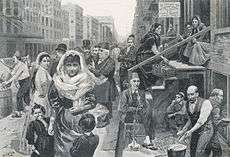
According to the International Organization for Migration, there are 13 million first-generation Arab migrants in the world, of which 5.8 million reside in Arab countries. Arab expatriates contribute to the circulation of financial and human capital in the region and thus significantly promote regional development. In 2009, Arab countries received a total of 35.1 billion USD in remittance in-flows and remittances sent to Jordan, Egypt and Lebanon from other Arab countries are 40 to 190 per cent higher than trade revenues between these and other Arab countries.[110]
The 250,000 strong Lebanese community in West Africa is the largest non-African group in the region.[111][112]
Arab traders have long operated in Southeast Asia and along the East Africa's Swahili coast. Zanzibar was once ruled by Omani Arabs.[113] Most of the prominent Indonesians, Malaysians, and Singaporeans of Arab descent are Hadhrami people with origins in southern Yemen in the Hadramawt coastal region.[114]
Central Asia and Caucasus
In 1728, a Russian officer described a group of Sunni Arab nomads who populated the Caspian shores of Mughan (in present-day Azerbaijan) and spoke a mixed Turkic-Arabic language.[115] It is believed that these groups migrated to the Caucasus in the 16th century.[116] The 1888 edition of Encyclopædia Britannica also mentioned a certain number of Arabs populating the Baku Governorate of the Russian Empire.[117] They retained an Arabic dialect at least into the mid-19th century,[118] but since then have fully assimilated with the neighbouring Azeris and Tats. Today in Azerbaijan alone, there are nearly 30 settlements still holding the name Arab (for example, Arabgadim, Arabojaghy, Arab-Yengija, etc.).
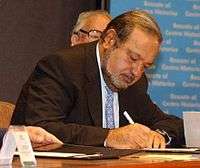
From the time of the Arab conquest of the Caucasus, continuous small-scale Arab migration from various parts of the Arab world occurred in Dagestan, which influenced local culture. Until the mid-20th century, some individuals in Dagestan still claimed Arabic as their native language. The majority of these lived in the village of Darvag, to the north-west of Derbent. The latest of these accounts dates to the 1930s.[116] Most Arab communities in southern Dagestan underwent linguistic Turkicisation, thus nowadays Darvag is a majority-Azeri village.[119][120]
According to the History of Ibn Khaldun, the Arabs that were once in Central Asia have been either killed or have fled the Tatar invasion of the region, leaving only the locals.[121] However, today many people in Central Asia identify as Arabs. Most Arabs of Central Asia are fully integrated into local populations, and sometimes call themselves the same as locals (for example, Tajiks, Uzbeks) but they use special titles to show their Arabic origin such as Sayyid, Khoja or Siddiqui.[122]
Iranian Arab communities are also found in Khuzestan Province.
South Asia
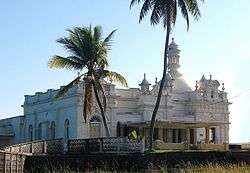
There are only two communities with the self-identity Arab in India, the Chaush of the Deccan region and the Chavuse of Gujarat,[123][124] who are by and large descended of Hadhrami migrants who settled in these two regions in the 18th Centuries. However, both these communities no longer speak Arabic, although with the Chaush, there has been re-immigration to Persian Gulf countries, and re-adoption of Arabic by these immigrants.[125] In South Asia, claiming Arab ancestry is considered prestigious, and many communities have origin myths with claim to an Arab ancestry. Examples include the Mappilla of Kerala, Labbai of Tamil Nadu. These communities all allege an Arab ancestry, but none speak Arabic and follow the customs and traditions of the Hindu majority.[126] Among Muslims of North India and Pakistan there are groups who claim the status of Sayyid, have origin myths that allege descent from the Prophet Mohammad. None of these Sayyid families speak Arabic or follow Arab customs or traditions.[127]Iraqi biradri can be considered as an Arab because the record of their ancestors who migrated from Iraq exists in historical documents.
History
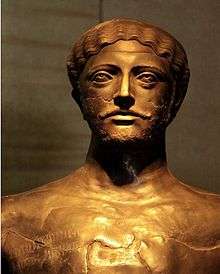
Pre-Islamic
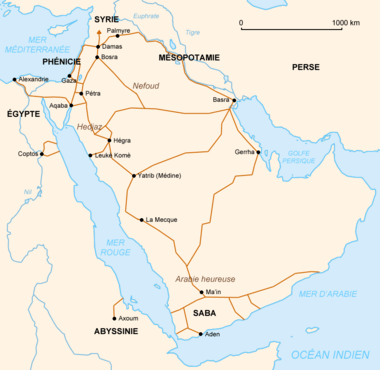
Pre-Islamic Arabia refers to Arabic civilization in the Arabian Peninsula before the rise of Islam in the 630s. The study of Pre-Islamic Arabia is important to Islamic studies as it provides the context for the development of Islam.
Origins and early history

Old Arabic diverges from Central Semitic by the beginning of the 1st millennium BC.
The first written attestation of the ethnonym "Arab" occurs in an Assyrian inscription of 853 BCE, where Shalmaneser III lists a King Gindibu of mâtu arbâi (Arab land) as among the people he defeated at the Battle of Karkar. Some of the names given in these texts are Aramaic, while others are the first attestations of Ancient North Arabian dialects. In fact several different ethnonyms are found in Assyrian texts that are conventionally translated "Arab": Arabi, Arubu, Aribi and Urbi. Many of the Qedarite queens were also described as queens of the aribi. The Hebrew Bible occasionally refers to Aravi peoples (or variants thereof), translated as "Arab" or "Arabian." The scope of the term at that early stage is unclear, but it seems to have referred to various desert-dwelling Semitic tribes in the Syrian Desert and Arabia. Arab tribes came into conflict with the Assyrians during the reign of the Assyrian king Ashurbanipal, and he records military victories against the powerful Qedar tribe among others.
Medieval Arab genealogists divided Arabs into three groups:
- "Ancient Arabs", tribes that had vanished or been destroyed, such as ʿĀd and Thamud, often mentioned in the Qur'an as examples of God's power to vanquish those who fought his prophets.
- "Pure Arabs" of South Arabia, descending from Qahtan. The Qahtanites (Qahtanis) are said to have migrated from the land of Yemen following the destruction of the Ma'rib Dam (sadd Ma'rib).
- The "Arabized Arabs" (mustaʿribah) of Central Arabia (Najd) and North Arabia, descending from Ishmael the elder son of Abraham, through Adnan (hence, Adnanites). The Book of Genesis narrates that God promised Hagar to beget from Ishmael twelve princes and turn him to a great nation.(Genesis 17:20) The Book of Jubilees claims that the sons of Ishmael intermingled with the 6 sons of Keturah, from Abraham, and their descendants were called Arabs and Ishmaelites:
And Ishmael and his sons, and the sons of Keturah and their sons, went together and dwelt from Paran to the entering in of Babylon in all the land towards the East facing the desert. And these mingled with each other, and their name was called Arabs, and Ishmaelites.— Book of Jubilees 20:13

Assyrian and Babylonian Royal Inscriptions and North Arabian inscriptions from 9th to 6th century B.C, mention the king of Qedar as king of the Arabs and King of the Ishmaelites.[128][129][130][131] Of the names of the sons of Ishmael the names "Nabat, Kedar, Abdeel, Dumah, Massa, and Teman" were mentioned in the Assyrian Royal Inscriptions as tribes of the Ishmaelites. Jesur was mentioned in Greek inscriptions in the First Century B.C.[132]
Ibn Khaldun's Muqaddima distinguishes between sedentary Arabian Muslims who used to be nomadic, and Bedouin nomadic Arabs of the desert. He used the term "formerly nomadic" Arabs and refers to sedentary Muslims by the region or city they lived in, as in Yemenis.[133] The Christians of Italy and the Crusaders preferred the term Saracens for all the Arabs and Muslims of that time.[134] The Christians of Iberia used the term Moor to describe all the Arabs and Muslims of that time.
Muslims of Medina referred to the nomadic tribes of the deserts as the A'raab, and considered themselves sedentary, but were aware of their close racial bonds. The term "A'raab' mirrors the term Assyrians used to describe the closely related nomads they defeated in Syria.
The Qur'an does not use the word ʿarab, only the nisba adjective ʿarabiy. The Qur'an calls itself ʿarabiy, "Arabic", and Mubin, "clear". The two qualities are connected for example in ayat 43.2–3, "By the clear Book: We have made it an Arabic recitation in order that you may understand". The Qur'an became regarded as the prime example of the al-ʿarabiyya, the language of the Arabs. The term ʾiʿrāb has the same root and refers to a particularly clear and correct mode of speech. The plural noun ʾaʿrāb refers to the Bedouin tribes of the desert who resisted Muhammad, for example in at-Tawba 97, al-ʾaʿrābu ʾašaddu kufrān wanifāqān "the Bedouin are the worst in disbelief and hypocrisy".
Based on this, in early Islamic terminology, ʿarabiy referred to the language, and ʾaʿrāb to the Arab Bedouins, carrying a negative connotation due to the Qur'anic verdict just cited. But after the Islamic conquest of the eighth century, the language of the nomadic Arabs became regarded as the most pure by the grammarians following Abi Ishaq, and the term kalam al-ʿArab, "language of the Arabs", denoted the uncontaminated language of the Bedouins.
Classical kingdoms

Proto-Arabic, or Ancient North Arabian, texts give a clearer picture of the Arabs' emergence. The earliest are written in variants of epigraphic south Arabian musnad script, including the 8th century BCE Hasaean inscriptions of eastern Saudi Arabia, the 6th century BCE Lihyanite texts of southeastern Saudi Arabia and the Thamudic texts found throughout Arabia and the Sinai (not in reality connected with Thamud).
The Nabataeans were nomadic newcomers who moved into territory vacated by the Edomites – Semites who settled the region centuries before them. Their early inscriptions were in Aramaic, but gradually switched to Arabic, and since they had writing, it was they who made the first inscriptions in Arabic. The Nabataean alphabet was adopted by Arabs to the south, and evolved into modern Arabic script around the 4th century. This is attested by Safaitic inscriptions (beginning in the 1st century BCE) and the many Arabic personal names in Nabataean inscriptions. From about the 2nd century BCE, a few inscriptions from Qaryat al-Faw (near Sulayyil) reveal a dialect no longer considered proto-Arabic, but pre-classical Arabic. Five Syriac inscriptions mentioning Arabs have been found at Sumatar Harabesi, one of which dates to the 2nd century CE.
Late kingdoms

The Ghassanids, Lakhmids and Kindites were the last major migration of pre-Islamic Arabs out of Yemen to the north.
- The Ghassanids increased the Semitic presence in the then Hellenized Syria, the majority of Semites were Aramaic peoples. They mainly settled in the Hauran region and spread to modern Lebanon, Palestine and East Jordan.
Greeks and Romans referred to all the nomadic population of the desert in the Near East as Arabi. The Romans called Yemen "Arabia Felix".[135] The Romans called the vassal nomadic states within the Roman Empire "Arabia Petraea" after the city of Petra, and called unconquered deserts bordering the empire to the south and east Arabia Magna.
- The Lakhmids as a dynasty inherited their power from the Tanukhids, the mid Tigris region around their capital Al-Hira. They ended up allying with the Sassanids against the Ghassanids and the Byzantine Empire. The Lakhmids contested control of the Central Arabian tribes with the Kindites with the Lakhmids eventually destroying Kinda in 540 after the fall of their main ally Himyar. The Persian Sassanids dissolved the Lakhmid dynasty in 602, being under puppet kings, then under their direct control.[136]
- The Kindites migrated from Yemen along with the Ghassanids and Lakhmids, but were turned back in Bahrain by the Abdul Qais Rabi'a tribe. They returned to Yemen and allied themselves with the Himyarites who installed them as a vassal kingdom that ruled Central Arbia from "Qaryah Dhat Kahl" (the present-day called Qaryat al-Faw) in Central Arabia. They ruled much of the Northern/Central Arabian peninsula, until they were destroyed by the Lakhmid king Al-Mundhir, and his son 'Amr
Islamic
Arab Caliphate

Rashidun Era (632-661)
After the death of Muhammad in 632, Rashidun armies launched campaigns of conquest, establishing the Caliphate, or Islamic Empire, one of the largest empires in history. It was larger and lasted longer than the previous Arab empires of Queen Mawia or the Palmyrene Empire, which was predominantly Syriac rather than Arab. The Rashidun state was a completely new state and not a mere imitation of the earlier Arab kingdoms such as the Himyarite, Lakhmids or Ghassanids, although it benefited greatly from their art, administration and architecture.
Umayyad Era (661-750)
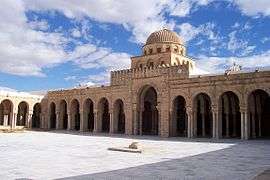
In 661, the Caliphate fell into the hands of the Umayyad dynasty and Damascus was established as the Muslim capital. They were proud of their Arab ancestry and sponsored the poetry and culture of pre-Islamic Arabia. They established garrison towns at Ramla, ar-Raqqah, Basra, Kufa, Mosul and Samarra, all of which developed into major cities.[138]
Caliph Abd al-Malik established Arabic as the Caliphate's official language in 686.[139] This reform greatly influenced the conquered non-Arab peoples and fueled the Arabization of the region. However, the Arabs' higher status among non-Arab Muslim converts and the latter's obligation to pay heavy taxes caused resentment. Caliph Umar II strove to resolve the conflict when he came to power in 717. He rectified the disparity, demanding that all Muslims be treated as equals, but his intended reforms did not take effect, as he died after only three years of rule. By now, discontent with the Umayyads swept the region and an uprising occurred in which the Abbasids came to power and moved the capital to Baghdad.
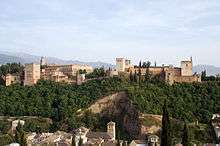
Umayyads expanded their Empire westwards capturing North Africa from the Byzantines. Before the Arab conquest, North Africa was inhibited by various people including Punics, Vandals and Greeks. It was not until the 11th century that the Maghreb saw a large influx of ethnic Arabs. Starting with the 11th century, the Arab bedouin Banu Hilal tribes migrated to the West. Having been sent by the Fatimids to punish the Berber Zirids for abandoning Shias, they travelled westwards.
The Banu Hilal quickly defeated the Zirids and deeply weakened the neighboring Hammadids. Their influx was a major factor in the Arabization of the Maghreb. Although Berbers ruled the region until the 16th century (under such powerful dynasties as the Almoravids, the Almohads, Hafsids, etc.), the arrival of these tribes eventually helped Arabize much of it ethnically, in addition to the linguistic and political impact local non-Arabs. With the collapse of the Umayyad state in 1031 AD, Islamic Spain was divided into small kingdoms.
Abbassid Era (750-1513)
The Abbasids led a revolt against the Umayyads and defeated them in the Battle of the Zab effectively ending their rule in all part of the Empire except Al-Andalus. The Abbasids were descendants of Muhammad's uncle Abbas, but unlike the Umayyads they had the support of non-Arab subjects of the Umayyads.[138] The Abbasids ruled for 200 years before they lost their central control when Wilayas began to fracture; afterwards, in the 1190s, there was a revival of their power, which was ended by the Mongols, who conquered Baghdad and killed the Caliph. Members of the Abbasid royal family escaped the massacre and resorted to Cairo, which had broken from the Abbasid rule two years earlier; the Mamluk generals taking the political side of the kingdom while Abbasid Caliphs were engaged in civil activities and continued patronizing science, arts and literature.
Golden Age of Islam
The Islamic Golden Age was inaugurated by the middle of the 8th century by the ascension of the Abbasid Caliphate and the transfer of the capital from Damascus to the newly founded city Baghdad. The Abbassids were influenced by the Qur'anic injunctions and hadith such as "The ink of the scholar is more holy than the blood of martyrs" stressing the value of knowledge. During this period the Muslim world became an intellectual centre for science, philosophy, medicine and education as the Abbasids championed the cause of knowledge and established the "House of Wisdom" (Arabic: بيت الحكمة) in Baghdad. Rival Muslim dynasties such as the Fatimids of Egypt and the Umayyads of al-Andalus were also major intellectual centres with cities such as Cairo and Córdoba rivaling Baghdad.[140]
Ottoman Empire

From 1516 to 1918, much of the Arab world was under the suzerainty of the Ottoman Empire. The Ottomans defeated the Mamluk Sultanate in Cairo, and ended the Abbasid Caliphate. Arabs did not feel the change of administration because the Ottomans modeled their rule after the previous Arab administration systems. After World War I when the Ottoman Empire was overthrown by the British Empire, former Ottoman colonies were divided up between the British and French as League of Nations mandates.
Modern
Arabs in modern times live in the Arab world, which comprises 22 countries in Western Asia, North Africa, and parts of the Horn of Africa. They are all modern states and became significant as distinct political entities after the fall and defeat and dissolution of the Ottoman Empire (1908–1922).
Religion
Arab are mostly Muslims with Sunni majority and Shia minority, one exception being the Ibadis, who predominate in Oman and can be found as small minorities in Algeria and Libya (mostly Berbers). There are also a minority of Ahmadi Muslims.[141] Arab Christians generally follow Eastern Churches such as the Greek Orthodox and Greek Catholic churches, though a minority of Protestant Church followers also exists; The Copts and the Maronites, who are sometimes associated with Arab people as well, follow the Coptic Church and Maronite Church accordingly. In Iraq most Christians are Assyrians rather than Arabs, and follow the Assyrian Church of the East, Syriac Orthodox and Chaldean Church.[142] The Greek Catholic church and Maronite church are under the Pope of Rome, and a part of the larger worldwide Catholic Church. There are also Arab communities consisting of Druze and Baha'is.[143][144]
Christianity was the most common religion throughout all these regions before the Arab conquest, although Judaism, Mandeanism, Sabianism, Manicheanism, Mithraism, Zoroastrianism, and remnants of Mesopotamian religion, Canaanite religion, Greco-Roman religion and Egyptian religion could still also be found. Linguistically, the major Semitic language before the Arab conquest was Aramaic, spoken in various forms.
Ancient times
Before the coming of Islam, most Arabs followed a pagan religion with a number of deities, including Hubal,[145] Wadd, Allāt,[146] Manat, and Uzza. A few individuals, the hanifs, had apparently rejected polytheism in favor of monotheism unaffiliated with any particular religion. Some tribes had converted to Christianity or Judaism. The most prominent Arab Christian kingdoms were the Ghassanid and Lakhmid kingdoms.[147] When the Himyarite king converted to Judaism in the late 4th century,[148] the elites of the other prominent Arab kingdom, the Kindites, being Himyirite vassals, apparently also converted (at least partly). With the expansion of Islam, polytheistic Arabs were rapidly Islamized, and polytheistic traditions gradually disappeared.[149][150]
Islam
Today, Sunni Islam dominates in most areas, overwhelmingly so in North Africa and the Horn of Africa. Shia Islam is dominant among the Arab population in Bahrain and southern Iraq while northern Iraq is mostly Sunni. Substantial Shia populations exist in Lebanon, Yemen, Kuwait, Saudi Arabia,[151] northern Syria and the al-Batinah region in Oman. There are small numbers of Ibadi and non-denominational Muslims too.[141]
Druze faith

The Druze community is concentrated in Lebanon, Syria, Israel and Jordan. Many Druze claim independence from other major religions in the area and consider their religion more of a philosophy. Their books of worship are called Kitab Al Hikma (Epistles of Wisdom). They believe in reincarnation and pray to five messengers from God. In Israel, the Druze have a status aparte from the general Arab population, treated as a separate ethno-religious community.
Christianity

In pre-Islamic Arabia, Christianity had a prominent presence among several Arab communities, including the Bahrani people of Eastern Arabia, the Christian community of Najran, in parts of Yemen, and among certain northern Arabian tribes such as the Ghassanids, Lakhmids, Taghlib, Banu Amela, Banu Judham, Tanukhids and Tayy. In the early Christian centuries, Arabia was sometimes known as Arabia heretica, due to its being "well known as a breeding-ground for heterodox interpretations of Christianity."[152]
Christians make up 5.5% of the population of Western Asia and North Africa.[44] A sizeable share of those are Arab Christians proper, and affiliated Arabic-speaking populations of Copts and Maronites. In Lebanon, Christians number about 40.5% of the population.[81] In Syria, Christians make up 10% of the population.[92] In West Bank and in Gaza Strip, Christians make up 8% and 0.7% of the populations, respectively.[86][87] In Egypt, Coptic Christians number about 10% of the population. In Iraq, Christians constitute 0.1% of the population.[153] In Israel, Arab Christians constitute 2.1% (roughly 9% of the Arab population).[154] Arab Christians make up 8% of the population of Jordan.[155] Most North and South American Arabs are Christian,[156] as are about half of Arabs in Australia who come particularly from Lebanon, Syria and Palestine. One well known member of this religious and ethnic community is Saint Abo, martyr and the patron saint of Tbilisi, Georgia.[157] Arab Christians are living also in a holy Christian cities such as Nazareth, Bethlehem and the Christian Quarter of the Old City of Jerusalem and many other villages with holy Christian sites.
Non-Arab religious groups in the Arab world
Judaism
The Jewish tribes of Arabia were Arabian tribes professing the Jewish faith that inhabited the Arabian Peninsula before and during the advent of Islam. It is not always clear whether they were originally Israelite in ancestry, genealogically Arab tribes that converted to Judaism, or a mixture of both. In Islamic tradition the Jewish tribes of the Hejaz were seen as the offspring of the ancient Israelites.[158]:4–5 According to Muslim sources, they spoke a language other than Arabic, which Al-Tabari claims was Persian. This implies they were connected to the major Jewish center in Babylon.[158]:5 Certain Jewish traditions records the existence of nomadic tribes such as the Rechabites that converted to Judaism in antiquity. The tribes collapsed with the rise of Islam, with many either converting or fleeing the Arab peninsula. Some of those tribes are thought to have merged into Yemenite Jewish community, while others, like the residents of Yatta consider themselves Islamized descendants of Khaybar, a Jewish tribe of Arabia.
Jews from Arab countries – included in the Mizrahi Jewish communities– are not categorized as, and do not consider themselves to be, Arabs, as Jews are a separate nation from Arabs, with different history and culture.[159] However, sometimes the term Arab Jews is used to describe Jews from Arab countries, though the term is highly controversial. Sociologist Sammy Smooha stated "This ("Arab Jews") term does not hold water. It is absolutely not a parallel to 'Arab Christian'".[160] Those who dispute the historicity of the term make the claim that Middle Eastern Jews are similar to Assyrians, Berbers, and other Middle Eastern groups who live in Arab societies as distinct minority groups with distinct identity and therefore are not categorized as Arabs.
Culture
Arab culture is a term that draws together the common themes and overtones found in the Arab countries, especially those of the Middle-Eastern countries. This region's distinct religion, art, and food are some of the fundamental features that define Arab culture.
Art
Arabic Art includes a wide range or artistic components, it can be Arabic miniature, calligraphy or Arabesque for modern and contemporary art,see Arab art scene.
Architecture
Arab Architecture has a deep diverse history, it dates to the dawn of the history in pre-Islamic Arabia. Each of it phases largely an extension of the earlier phase, it left also heavy impact on the architecture of other nations.
Music

Arabic music is the music of Arab people or countries. The world of Arab music has long been influenced by Cairo and Beirut, through musical innovation and regional styles. Lebanese musical pioneer Lydia Canaan fused Middle-Eastern quarter notes and microtones with anglophone rock,[161] making her the first internationally successful Lebanese recording artist[162][163][164] and widely regarded as the first rock star of the Middle East.[165][166][167][168][169]
Classical Arab music is extremely popular across the population, especially a small number of superstars known throughout the Arab world.

Regional styles of popular music include Algerian raï, Moroccan gnawa, Kuwaiti sawt, Egyptian el gil and Arabesque-pop music in Turkey.
Most historians agree that distinct forms of music existed in the Arabian peninsula in the pre-Islamic period between the 5th and 7th century AD. Ancient Arab poets recited poems with a high note. Islamic tradition holds that Jinns revealed poems to poets and music to musicians. The choir of the time was a pedagogic facility where educated poets recited poems. Singing was thought not the work of intellectuals, and was instead entrusted to women who learned to play instruments of the time, such as the drum, oud, or rebab, and perform the songs while respecting the poetic metre.
Literature

There is a small remnant of pre-Islamic poetry, but Arabic literature predominantly emerges in the Middle Ages, during the Golden Age of Islam.
Literary Arabic is derived from Classical Arabic, based on the language of the Quran as it was analyzed by Arabic grammarians beginning in the 8th century.
A large portion of Arabic literature before the 20th century is in the form of poetry, and even prose from this period is either filled with snippets of poetry or is in the form of saj or rhymed prose. The ghazal or love poem had a long history being at times tender and chaste and at other times rather explicit. In the Sufi tradition the love poem would take on a wider, mystical and religious importance. Arabic epic literature was much less common than poetry, and presumably originates in oral tradition, written down from the 14th century or so. Maqama or rhymed prose is intermediate between poetry and prose, and also between fiction and non-fiction. Maqama was an incredibly popular form of Arabic literature, being one of the few forms which continued to be written during the decline of Arabic in the 17th and 18th centuries.

Arabic literature and culture declined significantly after the 13th century, to the benefit of Turkish and Persian.
A modern revival took place beginning in the 19th century, alongside resistance against Ottoman rule. The literary revival is known as al-Nahda in Arabic, and was centered in Egypt and Lebanon.
Two distinct trends can be found in the nahda period of revival. The first was a neo-classical movement which sought to rediscover the literary traditions of the past, and was influenced by traditional literary genres—such as the maqama—and works like One Thousand and One Nights. In contrast, a modernist movement began by translating Western modernist works—primarily novels—into Arabic.
A tradition of modern Arabic poetry was established by writers such as Francis Marrash, Ahmad Shawqi and Hafiz Ibrahim. Iraqi poet Badr Shakir al-Sayyab is considered to be the originator of free verse in Arabic poetry.
Marriage
The practice of marrying of relatives is a common feature of Arab culture. In the Arab world today between 40% and 50% of all marriages are consanguineous or between close family members, though these figures may vary among Arab nations.[170][171] Studies have shown that 67% of Saudi marriages are between close relatives as are 54% of all marriages in Kuwait, whereas 29% of all marriages in Egypt and 18% of all Lebanese were between blood relatives.[172][173]
Due to the actions of the Prophet Muhammad and the Rightly Guided Caliphs, marriage between cousins is explicitly allowed in Islam and the Qur'an itself does not discourage or forbid the practice.[174] Nevertheless, opinions vary on whether the phenomenon should be seen as exclusively based on Islamic practices as a 1992 study among Arabs in Jordan did not show significant differences between Christian Arabs or Muslim Arabs when comparing the occurrence of consanguinity.[175]
Genetics
Y-chromosome
.svg.png)
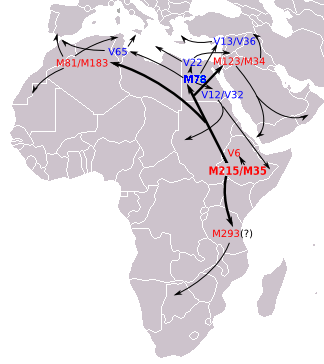
Haplogroup E1b1b is the most frequent paternal clade among the populations in the western part of the Arab world (Maghreb and Northeast Africa), whereas haplogroup J is the most frequent paternal clade toward the east (Arabian peninsula and Levant).[176]
Basal haplogroup J*(xJ1,J2) is found at its highest frequencies among the Socotri (71.4%).[177] The paternal ancestry found across all Arabic countries is Haplogroup J1, especially its major subclade J-P58, the haplogroup that spread with Arabic conquest in the 7th century. It was found that Haplogroup J1 occur at high frequencies among the Arabic-speaking populations of the Middle East and is the prevalent Y-chromosome lineage within the Near East. Haplogroup J1e (J-P58) is also associated with a Semitic linguistic common denominator, with the YCAII 22-22 allele state is closely associated with J1e.[178] J-P58 subclade of J1 is the single paternal lineage originating in the Near East of high frequency found in 72.7% of Marsh Arabs of Iraq, 70% of Bedouins, 68% of Yemenis, 55% of Jordanians, 55% of Palestinian Arabs, 48% of Omani People, 48.7% of Jordanians, 44.4% of Syrian Arabs, 34% of Tunisians, 35% of Algerians,[179][180][181][182][183] and its precipitations drop in frequency as one moves away from Saudi Arabia and the Near East. J-P58 include all the J1-CMH haplotypes and is YCAII=22-22 motif, both are found in Arabs and J1-Cohanim (Y-chromosomal Aaron).[184][185] The motif YCAII=22-22 characterize a monophyletic clad found in Arabs but less frequent in Ethiopian J1 and rare in Europe and Caucasus.[186][187] It has now been resolved that the Arabic clade J1-P58, L147.1 (the major clad of P58 and still the major clade of J1) include all CMH haplotypes and is YCAII=22-22 (both specific to Arabs and J1-Cohanim) was the J1 clade that spread far and wide by the Islamic conquest.[188] Both Qahtanite and Adnanite Arabs are J1-P58 haplogroup since the Arabs of North Africa like Algeria (known to have Qahtanite lineage from the Arab conquest and Adnanite lineage from Bani Hilal and bani Sulaim migration to North Africa in the 10th century by the Fatimides, yet only E of the Berber and J1 are found in Arabs of North Africa and this J1 is marked by CMH and the motif YCAII=22-22. The J2 in Algerian Arabs is minor 3% and is of the rare J2-M67 of Chechnya, rarely found in other Arabic countries and non existent in Arabian Peninsula and Yemen.[189][190] The Arab conquest appears to have had a dramatic influence on the East and South Mediterranean coasts. The presence of Arab Y chromosome lineages in the Middle East suggests that most have experienced substantial gene flow from the Arabian peninsula.[191]
mtDNA analysis
The Maternal ancestral lineages of Arabic countries are very diverse. The original Historical Maternal ancestral Haplogroups of the Near East were Mt (Maternal) L3 Haplogroup and Mt HV1 haplogroup that are still high in Yemen, while in Greater Syria there is a European Maternal gene flow. In North West Africa (Morocco, Algeria and Tunisia) the dominant Maternal lineage is the rare Scandinavian European U8 haplogroup probably came with the Vandals when escaped from Spain from the Visigoths.[179][192][193]
HLA antigens
Many of the genetic disorders specific to Arabs are located on HLA segment on chromosome 6. These same segment mutations are also markers of Arabs in Genealogical and forensic profiling tests and studies. Such studies as: Arab population data on the PCR-based loci: HLA[194] HLA polymorphism in Saudi.[195] Other mixed DNA studies on Arabic populations[179][192][193][196][197]
Autosomal DNA
There are four principal West Eurasian autosomal DNA components that characterize the populations in the Arab world: the Arabian, Levantine, Coptic and Maghrebi components. The Arabian component is the main autosomal element in the Gulf region. It is most closely associated with local Arabic-speaking populations.[198] The Arabian component is also found at significant frequencies in parts of the Levant and Northeast Africa.[198][199] The geographical distribution pattern of this component correlates with the pattern of the Islamic expansion, but its presence in Lebanese Christians, Sephardi and Ashkenazi Jews, Cypriots and Armenians might suggest that its spread to the Levant could also represent an earlier event.[198]
The Levantine component is the main autosomal element in the Near East and Caucasus. It peaks among Druze populations in the Levant. The Levantine component diverged from the Arabian component about 15,500-23,700 ypb.[198]
The Coptic component is the main autosomal element in Northeast Africa. It peaks among Egyptian Copts in Sudan, and is also found at high frequencies among other Afro-Asiatic-speaking populations in the Nile Valley and Horn of Africa.[200] The Coptic component is roughly equivalent with the Ethio-Somali component.[201]
The Maghrebi component is the main autosomal element in the Maghreb. It peaks among the non-Arabized Berber populations in the region.[199] The Maghrebi component diverged from the Coptic/Ethio-Somali, Arabian and Levantine components prior to the Holocene.[199][201]
See also
References
- Notes
- 1 2 Margaret Kleffner Nydell Understanding Arabs: A Guide For Modern Times, Intercultural Press, 2005, ISBN 1931930252, page xxiii, 14
- ↑ total population 450 million, CIA Factbook estimates an Arab population of 450 million, see article text.
- ↑ Brazil - Brasil - BRAZZIL - News from Brazil - Arabs: They are 12 Million in Brazil - Brazilian Immigration - September 2004
- ↑ By (2008-01-29). "French-Arabs battle stereotypes - Entertainment News, French Cinema, Media". Variety. Retrieved 2010-08-22.
- 1 2 "الهجرة السورية اللبنانية إلى الأرجنتين". Fearab.org.ar. Archived from the original on 20 June 2010. Retrieved 13 April 2010.
- 1 2 "The Arab American Institute". Aaiusa.org. Archived from the original on 1 June 2006. Retrieved 17 September 2011.
- 1 2 Joshua Project. "Country - Turkey :: Joshua Project Joshua Project". Retrieved 24 March 2015.
- 1 2 http://www.cbs.gov.il/www/hodaot2013n/11_13_097e.pdf
- 1 2 "Abdel el-Zabayar: From Parliament to the Frontlines". The Daily Beast.
- 1 2 "Las mil y una historias" (in Spanish). semana.com. 2004.There is an estimated population of 1,500,000 Arabs in Colombia.
- 1 2 "Iran". Archived from the original on 24 April 2013. Retrieved 3 August 2013.
- 1 2 "Chad". Archived from the original on 24 April 2013. Retrieved 3 August 2013.
- 1 2 http://www.cz-herborn.de/arabische/
- 1 2 Ben Cahoon. "World Statesmen.org". World Statesmen.org. Retrieved 17 September 2011.
- 1 2 (Spanish) En Chile viven unas 700.000 personas de origen árabe y de ellas 500.000 son descendientes de emigrantes palestinos que llegaron a comienzos del siglo pasado y que constituyen la comunidad de ese origen más grande fuera del mundo árabe.
- ↑ Anthony McRoy. "The British Arab". National Association of British Arabs. Retrieved 17 April 2012.
- ↑ "Statistics Canada". Statistics Canada. Retrieved 2013-07-16.
- ↑ "Dutch media perceived as much more biased than Arabic media – Media & Citizenship Report conducted by University of Utrecht" (PDF), Utrecht University, 10 September 2010, retrieved 29 November 2010
- ↑ "Monash University Research Repository" (PDF). Retrieved 24 March 2015.
- ↑ Larry Luxner (2001). "The Arabs of Honduras". Saudi Aramco World. Retrieved 11 February 2016.
- ↑ Sharif, William (2010). Christianity, Islam and Secular Criticism. p. 44.
- ↑ Medieval Islamic Civilization: An Encyclopedia - Page 332, Josef W. Meri - 2005
- ↑ An Introduction to the Baha'i Faith - Page 88, Peter Smith - 2008
- ↑ Frishkopf, Michael (2010). "Introduction: Music and media in the Arab world and Music and media in the Arab world as music and media in the Arab world: A metadiscourse". In Frishkopf, Michael. Music and media in the Arab world. Cairo: The American University in Cairo Press. p. 61. ISBN 978-977-416-293-0.
- 1 2 Haseeb, Khair El-Din (2012). The Arabs and Africa (RLE: The Arab Nation). Routledge. p. 27. ISBN 1136251928. Retrieved 28 September 2016.
- ↑ Arab (people)
- ↑ Kjeilen, Tore. "Arabs - LookLex Encyclopaedia". looklex.com.
- ↑ "Who is an Arab?". al-bab.com.
- ↑ War of Visions: Conflict of Identities in the Sudan. p 405. By Francis Mading Deng
- ↑ Genetic Evidence for the Expansion of Arabian Tribes into the Southern Levant and North Africa
- ↑ A Predominantly Neolithic Origin for Y-Chromosomal DNA Variation in North Africa
- ↑ Frishkopf (ed.), Michael (2010). Music and media in the Arab world. Cairo: The American University in Cairo Press. pp. 42–43. ISBN 9774162935.
- ↑ Jonathan Porter Berkey (2003). The Formation of Islam: Religion and Society in the Near East, 600-1800. Cambridge University Press. p. 42. ISBN 978-0-521-58813-3.
- ↑ Neal Robinson (5 November 2013). Islam: A Concise Introduction. Routledge. p. 75. ISBN 978-1-136-81773-1.
- ↑ "Religious Diversity Around The World - Pew Research Center". Pew Research Center's Religion & Public Life Project. 4 April 2014.
- ↑ Phares, Walid (2001). "Arab Christians: An Introduction". Arabic Bible Outreach Ministry. Archived from the original on 5 November 2004.
- 1 2 Retsö, Jan (2003). The Arabs in Antiquity: Their History from the Assyrians to the Umayyads. Psychology Press. ISBN 978-0-7007-1679-1., pages 105, 119, 125-127.
- ↑ Hans Wehr & J M. Cowan. A dictionary of modern written Arabic. Third Edition. Ithaca, N.Y.: Spoken Language Services. p. 601.
- ↑ William Bowden; Luke Lavan; Carlos Machado (2004). Recent Research on the Late Antique Countryside. Brill. p. 91.
- ↑ Ira M. Lapidus (2014). A History of Islamic Societies. Cambridge University Press. p. 29.
- ↑ Hornblower, Simon & Spawforth, Antony, editors. (1996), Oxford classical dictionary. (3rd ed). Oxford ; New York : Oxford University Press. p. 135. ISBN 9780198661726
- ↑ Ori Stendel. The Arabs in Palestine. Sussex Academic Press. p. 45. ISBN 1898723249. Retrieved March 4, 2014.
- ↑ Mohammad Hassan Khalil. Between Heaven and Hell: Islam, Salvation, and the Fate of Others. Oxford University Press. p. 297. Retrieved March 1, 2014.
- 1 2 Andrea Pacini, ed. (1998). Christian Communities in the Middle East. Oxford University Press. ISBN 0-19-829388-7.
- 1 2 3 "Ethnic Groups". CIA. Retrieved 10 July 2016.
- ↑ US Census Directive 15 "Race and Ethnic Standards for Federal Statistics and Administrative Reporting"
- ↑ "About Race - People and Households - U.S. Census Bureau". Retrieved 24 March 2015.
- ↑ US Census, "Overview of Race and Hispanic Origin 2010"
- ↑ "Arab". Dictionary.reference.com. 22 March 1945. Archived from the original on 20 April 2010. Retrieved 13 April 2010.
- ↑ Chegne, Anwar G. (Autumn 1965). "Arabic: Its Significance and Place in Arab-Muslim Society". Middle East Journal (19): 447–470.
- ↑ "Islam and the Arabic language". Islam.about.com. 3 November 2009. Retrieved 13 April 2010.
- ↑ "Banu Judham migration". Witness-pioneer.org. 16 September 2002. Archived from the original on 4 May 2010. Retrieved 13 April 2010.
- ↑ "Ghassanids Arabic linguistic influence in Syria". Personal.umich.edu. Archived from the original on 27 May 2010. Retrieved 13 April 2010.
- ↑ (Regueiro et al.) 2006; found agreement by (Battaglia et al.) 2008
- ↑ Jankowski, James. "Egypt and Early Arab Nationalism" in Rashid Kakhlidi, ed., Origins of Arab Nationalism, pp. 244–245
- ↑ Quoted in Dawisha, Adeed. Arab Nationalism in the Twentieth Century. Princeton University Press. 2003, ISBN 0-691-12272-5, p. 99
- ↑ 1996, p.xviii
- ↑ Dwight Fletcher Reynolds, Arab folklore: a handbook, (Greenwood Press: 2007), p.1.
- ↑ Sadek Jawad Sulaiman, The Arab Identity. Sadek Jawad Sulaiman. Al-Hewar/The Arab-American Dialogue Winter 2007. Chairman of Al-Hewar Center's Advisory Board.
- ↑ Hugh Kennedy The Armies of the Caliphs: Military and Society in the Early Islamic State p.33 Routledge, Jun 17, 2013 ISBN 1134531133
- ↑ Hall, Bruce S., A History of Race in Muslim West Africa, 1600-1960. Cambridge University Press, 2011.
- ↑ Clio. "François Decret, Les invasions hilaliennes en Ifrîqiya - Clio - Voyage Culturel". www.clio.fr. Retrieved 2015-09-28.
- 1 2 Semino2004
- ↑ 31% is based on Combined Data
- Semino 2004: 30%
- Arredi 2004: 32%
- ↑ Cruciani (2007)
- ↑ Semino (2004)
- ↑ Histoire des Berbères et des dynasties musulmanes de l'Afrique septentrionale par Ibn Khaldoun
- ↑ Booth, Marilyn. Arab Adolescents Facing the Future: Enduring Ideals and Pressure to Change. Cambridge University Press. pp. 207–242.
- ↑ "Pact of the League of Arab States, March 22, 1945". Yale Law School. Retrieved 9 July 2016.
- 1 2 Ghazi O. Tadmouri, Konduru S. Sastry, Lotfi Chouchane (2014). "Arab gene geography: From population diversities to personalized medical genomics". Global Cardiology Science and Practice. 54. doi:10.5339/gcsp.2014.54. Retrieved 1 December 2016.
- ↑ Ammon, Ulrich (2006). Sociolinguistics: An International Handbook of the Science of Language and Society, Part 3 - Volume 3. Walter de Gruyter. p. 1918. ISBN 3110184184. Retrieved 28 September 2016.
- ↑ "CIA World Factbook: Algeria". 20 March 2014. Archived from the original on 13 October 2012.
- ↑ "CIA World Factbook: Bahrain". 23 June 2014.
- ↑ "CIA World Factbook: Chad". 23 June 2014.
- ↑ "CIA World Factbook: Comoros". 26 July 2016.
- ↑ "CIA World Factbook: Djibouti". 23 June 2014.
- ↑ "CIA World Factbook: Egypt". 22 June 2014.
- ↑ "CIA World Factbook: Iraq". 20 March 2014.
- ↑ Ghazal, Mohammad (22 January 2016). "Population stands at around 9.5 million, including 2.9 million guests". The Jordan Times. The Jordan News. Retrieved 22 January 2016.
- ↑ "Kuwait Population Census". 2015.
- 1 2 "CIA World Factbook: Lebanon". 20 June 2014.
- ↑ "CIA World Factbook: Libya". 20 June 2014.
- ↑ "CIA World Factbook: Mauritania". 20 June 2014.
- ↑ "CIA World Factbook: Morocco". 20 June 2014.
- ↑ "CIA World Factbook: Oman". 22 June 2014.
- 1 2 "CIA World Factbook: Gaza Strip". 3 November 2013.
- 1 2 "CIA World Factbook: West Bank". 3 November 2013.
- ↑ "CIA World Factbook: Qatar". 20 June 2014.
- ↑ "CIA World Factbook: Saudi Arabia". 20 June 2014.
- ↑ "CIA World Factbook: Somalia". 23 June 2014.
- ↑ "CIA World Factbook: Sudan". 20 June 2014.
- 1 2 "CIA World Factbook: Syria". 20 June 2014.
- ↑ "CIA World Factbook: Tunisia". 20 June 2014.
- ↑ "CIA World Factbook: United Arab Emirates". 20 June 2014.
- ↑ "CIA World Factbook: Yemen". 20 March 2014.
- ↑ "Saudi Aramco World : The Arabs of Brazil". saudiaramcoworld.com.
Of Brazil's 186 million inhabitants, an estimated nine million, or five percent, can point to roots in the Middle East
- ↑ "France's ethnic minorities: To count or not to count". The Economist. 26 March 2009. Retrieved 12 July 2013.
- ↑ "Hadramaut dan Para Kapiten Arab". Retrieved 24 March 2015.
- ↑ http://islamhoy.com/actualidad/analisis/estudio-demografico-orientativo-sobre-la-poblacion-musulmana-en-espana/
- ↑ http://blogs.elpais.com/miradas-arabes/2014/02/poblacion-cuantos-musulmanes-espana-3-por-ciento-2014.html
- ↑ http://www.europapress.es/sociedad/noticia-musulmanes-espana-superan-18-millones-20150330182141.html
- ↑ http://www.alertadigital.com/2012/10/09/la-cifra-de-musulmanes-en-espana-casi-alcanza-los-16-millones-de-los-que-casi-un-tercio-viven-en-cataluna/
- ↑ "British Arabs". Retrieved 24 March 2015.
- ↑ "إحصائيات كندا: الجمهرة وفقًا للأصول العرقية، في كل محافظة وإقليم (إحصاء سنة 2006)".
- ↑ "Dutch media perceived as much more biased than Arabic media – Media & Citizenship Report conducted by University of Utrecht" (PDF), Utrecht University, 10 September 2010, retrieved 29 November 2010
- ↑ "Monash University Research Repository" (PDF). Retrieved 24 March 2015.
- ↑ http://joshuaproject.net/countries/SW
- ↑ http://www.joshuaproject.net/people-profile.php?peo3=10375&rog3=AU
- ↑ https://guardian.co.tt/sites/default/files/story/2011_DemographicReport.pdf | page 15
- ↑ Intra-Regional Labour Mobility in the Arab World, International Organization for Migration (IOM) Cairo
- ↑ "Lebanese in west Africa: Far from home". The Economist. 20 May 2011.
- ↑ "Tenacity and risk – the Lebanese in West Africa". BBC News. 10 January 2010.
- ↑ "Zanzibar profile". BBC News. 18 July 2012.
- ↑ "The world's successful diasporas". Managementtoday.co.uk. 3 April 2007.
- ↑ Genko, A. The Arabic Language and Caucasian Studies. USSR Academy of Sciences Publ. Moscow-Leningrad. 8–109
- 1 2 Zelkina, Anna. Arabic as a Minority Language. Walter de Gruyter, 2000; ISBN 3-11-016578-3 p. 101
- ↑ Baynes, Thomas Spencer (ed). "Transcaucasia." Encyclopædia Britannica. 1888. p. 514
- ↑ Golestan-i Iram by Abbasgulu Bakikhanov. Translated by Ziya Bunyadov. Baku: 1991, p. 21
- ↑ Seferbekov, Ruslan. Characters Персонажи традиционных религиозных представлений азербайджанцев Табасарана. Archived 16 December 2008 at the Wayback Machine.
- ↑ Stephen Adolphe Wurm et al. Atlas of languages of intercultural communication. Walter de Gruyter, 1996; p. 966
- ↑ History of Ibn Khaldun
- ↑ Arabic As a Minority Language By Jonathan Owens, pg. 184
- ↑ People of India: Vol. XIII: Andhra Pradesh (3 Parts-Set)Edited by D.L. Prasada Rao, N.V.K. Rao and S. Yaseen Saheb, Affiliated East-West Press
- ↑ People of India: Volume XXII: Gujarat (3 Parts-Set) : Edited by R.B. Lal, P.B.S.V. Padmanabham, Gopal Krishan and Md. Azeez Mohidden, Popular Prakashan for ASI, 2003
- ↑ Muslim society in transition Javed, Arifa Kulsoom ISBN 81-7169-096-3
- ↑ Frontiers of embedded Muslim communities in India / editor, Vinod K. Jairath ISBN 9780415668880
- ↑ Muslim caste in Uttar Pradesh: (a study of culture contact) by Ansari, G, (Ghaus)
- ↑ Delitzsche (1912). Assyriesche Lesestuche. Leipzig. OCLC 2008786.
- ↑ Montgomry (1934). Arabia and the Bible. Philadelphia: U of Pennsylvania. OCLC 639516.
- ↑ Winnet (1970). Ancient Records from North Arabia. pp. 51, 52. OCLC 79767.
king of kedar (Qedarites) is named alternatively as king of Ishmaelites and king of Arabs in Assyrian Inscriptions
- ↑ Stetkevychc (2000). Muhammad and the Golden Bough. Indiana University Press. ISBN 0253332087.
Assyrian records document Ishmaelites as Qedarites and as Arabs
- ↑ Hamilton, Victor P. (1990). The book of Genesis ([Nachdr.] ed.). Grand Rapids, Mich.: William B. Eerdmans. ISBN 0802823092.
- ↑ "Levity.com, Islam". Levity.com. Retrieved 13 April 2010.
- ↑ "www.eyewitnesstohistory.com". www.eyewitnesstohistory.com. Archived from the original on 2 April 2010. Retrieved 13 April 2010.
- ↑ "Dionysius Periegetes". www.cartographic-images.net.
- ↑ Harold Bailey The Cambridge history of Iran: The Seleucid, Parthian and Sasanian periods, Volume 1, Cambridge University Press, 1983, ISBN 0-521-20092-X p. 59
- ↑ Clifford Edmund Bosworth Historic cities of the Islamic world, Brill, Leyde, 2007, ISBN 90-04-15388-8 p. 264
- 1 2 Lunde, Paul (2002). Islam. New York: Dorling Kindersley Publishing. pp. 50–52. ISBN 0-7894-8797-7.
- ↑ John Joseph Saunders, A history of medieval Islam, Routledge, 1965, page 13
- ↑ Vartan Gregorian, "Islam: A Mosaic, Not a Monolith", Brookings Institution Press, 2003, pg 26–38 ISBN 0-8157-3283-X
- 1 2 See, for example:
- Ori Stendel. The Arabs in Israel. Sussex Academic Press. p. 45. ISBN 1898723249. Retrieved March 4, 2014.
- Mohammad Hassan Khalil. Between Heaven and Hell: Islam, Salvation, and the Fate of Others. Oxford University Press. p. 297. Retrieved March 1, 2014.
- ↑ United Networks. "CHRISTIANS (in the Arab world)". Medea.be. Retrieved 13 April 2010.
- ↑ The Bahá'í World Centre: Focal Point for a Global Community, The Bahá'í International Community, archived from the original on 29 June 2007, retrieved 2 July 2007
- ↑ "Shishakli and the Druzes: Integration and Intransigence"
- ↑ "Is Hubal The Same As Allah?". Islamic-awareness.org. Archived from the original on 25 March 2010. Retrieved 13 April 2010.
- ↑ Dictionary of Ancient Deities. Oxford University Press. ISBN 0-19-514504-6.
- ↑ "From Marib The Sabean Capital To Carantania". Buzzle.com. Retrieved 13 April 2010.
- ↑ Msn Encarta entry on Himyarites. Archived from the original on 31 October 2009.
- ↑ "History of Islam". Mnsu.edu. 6 January 2009. Retrieved 13 April 2010.
- ↑ "Encyclopedia of Politics and Religion". Cqpress.com. Archived from the original on 28 April 2010. Retrieved 13 April 2010.
- ↑ Lionel Beehner. "Shia Muslims in the Mideast". Cfr.org. Archived from the original on 11 April 2010. Retrieved 13 April 2010.
- ↑ Kamal S. Salibi (2003). A House of Many Mansions: The History of Lebanon Reconsidered (illustrated, reprint, revised ed.). I.B.Tauris. p. 88. ISBN 9781860649127.
- ↑ Arab Christians – Who are they?. Arabicbible.com. Retrieved on 2011-01-03.
- ↑ "CIA The World Factbook – Israel". Cia.gov. Archived from the original on 29 June 2011. Retrieved 18 July 2011.
- ↑ "CIA The World Factbook – Jordan". Cia.gov. Archived from the original on 29 June 2011. Retrieved 18 July 2011.
- ↑ "The Arab American Institute | Arab Americans". Aaiusa.org. Archived from the original on 3 April 2010. Retrieved 10 March 2010.
- ↑ Mgaloblishvili, Tamila (1998). Ancient Christianity in the Caucasus. Routledge. p. 272. ISBN 0-7007-0633-X.
- 1 2 Gil, Moshe (1997). The origin of the Jews of Yathrib. ISBN 9789004138827.
- ↑
- Ethnic minorities in English law – Google Books. Books.google.co.uk. Retrieved on 2010-12-23.
- Edgar Litt (1961). "Jewish Ethno-Religious Involvement and Political Liberalism". Social Forces. 39 (4): 328–332. doi:10.2307/2573430. JSTOR 2573430.
- "Are Jews a Religious Group or an Ethnic Group?" (PDF). Institute for Curriculum Services. Retrieved 2013-10-21.
- Sean Ireton (2003). "The Samaritans – A Jewish Sect in Israel: Strategies for Survival of an Ethno-religious Minority in the Twenty First Century". Anthrobase. Retrieved 2009-12-30.
- Levey, Geoffrey Brahm. "Toward a Theory of Disproportionate American Jewish Liberalism" (PDF).
- J. Alan Winter (March 1996). "Symbolic Ethnicity or Religion Among Jews in the United States: A Test of Gansian Hypotheses". Review of Religious Research. 37 (3).
- ↑ Lee, Vered. (2008-05-18) Conference asks: Iraqi Israeli, Arab Jew or Mizrahi Jew? - Israel News | Haaretz Daily Newspaper. Haaretz.com. Retrieved on 2013-07-12.
- ↑ David Sinclair, Billboard, May 10, 1997
- ↑ George Hayek, Al-Hayat, No. 12,513, June 3, 1997
- ↑ Mireille Khalife, Al-Hayat, Issue No. 13,732, October 16, 2000
- ↑ Lydia Canaan Receiving Lebanese International Success Award
- ↑ O'Connor, Tom. "Lydia Canaan One Step Closer to Rock n' Roll Hall of Fame", The Daily Star, Beirut, April 27, 2016.
- ↑ Justin Salhani, The Daily Star, November 17, 2014
- ↑ David Livingstone, Campus, No. 8, p. 2, February 1997
- ↑ Wafik Ajouz, Cedar Wings, No. 28, p. 2, July-August 1995
- ↑ Youmna Aschkar, Eco News, No. 77, p. 2, January 20, 1997
- ↑ Centre for Arabic Genomic Research
- ↑ Scientific study on the consequences of inbreeding in the Arab world
- ↑ The incidence of consanguinity was 54.3% among Kuwaiti natives and higher among Bedouins.
- ↑ Source contains figures for Saudi-Arabia, Lebanon and Egypt.
- ↑ Surah chapter 4, verse 23
- ↑ "The pattern was also independent of religious beliefs as both Christians and Muslims showed similar results."
- ↑ Bekada, A.; Fregel, R.; Cabrera, V. M.; Larruga, J. M.; Pestano, J.; Benhamamouch, S.; González, A. M. (2013). Pereira, Luísa Maria Sousa Mesquita, ed. "Introducing the Algerian Mitochondrial DNA and Y-Chromosome Profiles into the North African Landscape". PLoS ONE. 8 (2): e56775. doi:10.1371/journal.pone.0056775. PMC 3576335
 . PMID 23431392.
. PMID 23431392. - ↑ Černý, Viktor; et al. (2009). "Out of Arabia—the settlement of island Soqotra as revealed by mitochondrial and Y chromosome genetic diversity" (PDF). American journal of Physical Anthropology. 138 (4): 439–447. doi:10.1002/ajpa.20960. Retrieved 20 October 2016.
- ↑ Chiaroni; King, Roy J; Myres, Natalie M; Henn, Brenna M; Ducourneau, Axel; Mitchell, Michael J; Boetsch, Gilles; Sheikha, Issa; Lin, Alice A; Nik-Ahd, Mahnoosh; Ahmad, Jabeen; Lattanzi, Francesca; Herrera, Rene J; Ibrahim, Muntaser E; Brody, Aaron; Semino, Ornella; Kivisild, Toomas; Underhill, Peter A; et al. (14 October 2009). "The emergence of Y-chromosome haplogroup J1e among Arabic-speaking populations". European Journal of Human Genetics. 18 (3): 348–353. doi:10.1038/ejhg.2009.166. PMC 2987219
 . PMID 19826455.
. PMID 19826455. - 1 2 3 Al-Zahery, N; Pala, M; Battaglia, V; Grugni, V; Hamod, MA; Hooshiar Kashani, B; Olivieri, A; Torroni, A; Santachiara-Benerecetti, AS; Semino, O (4 October 2011). "In search of the genetic footprints of Sumerians: a survey of Y-chromosome and mtDNA variation in the Marsh Arabs of Iraq.". BMC Evolutionary Biology. 11: 288. doi:10.1186/1471-2148-11-288. PMC 3215667
 . PMID 21970613.
. PMID 21970613. - ↑ Chiaroni (2008). "Correlation of annual precipitation with human Y-chromosome diversity and the emergence of Neolithic agricultural and pastoral economies in the Fertile Crescent". Antiquity. 82 (316): 281–289. doi:10.1017/s0003598x00096800.
- ↑ Regueiro; et al. (2004). "The Levantine versus the Horn of Africa:evidence for bi-directional corridors of human migrations". American Journal of Human Genetics. 74 (3): 532–44. doi:10.1086/382286. PMC 1182266
 . PMID 14973781.
. PMID 14973781. - ↑ Cadenas at Al; Zhivotovsky, Lev A; Cavalli-Sforza, Luca L; Underhill, Peter A; Herrera, Rene J (10 October 2007). "Y-chromosome diversity characterizes the Gulf of Oman". European Journal of Human Genetics. 16 (3): 374–386. doi:10.1038/sj.ejhg.5201934. PMID 17928816.
- ↑ "Family Tree DNA Arabian YDNA Project".
- ↑ "Geographical distribution of J1-P58". Human Genetics. 126 (5): 707–17. November 2009. doi:10.1007/s00439-009-0727-5. PMC 2771134
 . PMID 19669163.
. PMID 19669163. - ↑ Hammer, Michael F.; Behar, Doron M.; Karafet, Tatiana M.; Mendez, Fernando L.; Hallmark, Brian; Erez, Tamar; Zhivotovsky, Lev A.; Rosset, Saharon; Skorecki, Karl (8 August 2009). "Extended Y chromosome haplotypes resolve multiple and unique lineages of the Jewish priesthood". Human Genetics. 126 (5): 707–717. doi:10.1007/s00439-009-0727-5. PMC 2771134
 . PMID 19669163.
. PMID 19669163. - ↑ "Origin, Diffusion, and Differentiation of Y-Chromosome Haplogroups E and J: Inferences on the Neolithization of Europe and Later Migratory Events in the Mediterranean Area". The American Journal of Human Genetics. 74 (5): 1023–34. May 2004. doi:10.1086/386295. PMC 1181965
 . PMID 15069642.
. PMID 15069642. YCAII=22-22 motif covers the core of J1 (J-M267) network
- ↑ Semino; Magri, Chiara; Benuzzi, Giorgia; Lin, Alice A.; Al-Zahery, Nadia; Battaglia, Vincenza; MacCioni, Liliana; Triantaphyllidis, Costas; Shen, Peidong; Oefner, Peter J.; Zhivotovsky, Lev A.; King, Roy; Torroni, Antonio; Cavalli-Sforza, L. Luca; Underhill, Peter A.; Santachiara-Benerecetti, A. Silvana; et al. (1 May 2004). "Origin, Diffusion, and Differentiation of Y-Chromosome Haplogroups E and J: Inferences on the Neolithization of Europe and Later Migratory Events in the Mediterranean Area". The American Journal of Human Genetics. 74 (5): 1023–1034. doi:10.1086/386295. PMC 1181965
 . PMID 15069642.
. PMID 15069642. - ↑ "J1-P58 contain the Arabic cluster L147.1 that contain the all J1-CMH haplotypes and is YCAII=22-22".
- ↑ Robino, C; Crobu, F; Di Gaetano, C; Bekada, A; Benhamamouch, S; Cerutti, N; Piazza, A; Inturri, S; Torre, C (May 2008). "Analysis of Y-chromosomal SNP haplogroups and STR haplotypes in an Algerian population sample". International journal of legal medicine. 122 (3): 251–5. doi:10.1007/s00414-007-0203-5. PMID 17909833.
- ↑ NEBEL; et al. (1 June 2002). "Genetic Evidence for the Expansion of Arabian Tribes into the Southern Levant and North Africa". The American Journal of Human Genetics. 70 (6): 1594–1596. doi:10.1086/340669. PMC 379148
 . PMID 11992266.
. PMID 11992266. - ↑ Capelli, C.; Redhead, N.; Romano, V.; Cali, F.; Lefranc, G.; Delague, V.; Megarbane, A.; Felice, A. E.; Pascali, V. L.; Neophytou, P. I.; Poulli, Z.; Novelletto, A.; Malaspina, P.; Terrenato, L.; Berebbi, A.; Fellous, M.; Thomas, M. G.; Goldstein, D. B. (1 March 2006). "Population Structure in the Mediterranean Basin: A Y Chromosome Perspective". Annals of Human Genetics. 70 (2): 207–225. doi:10.1111/j.1529-8817.2005.00224.x. PMID 16626331.
- 1 2 Yanni, EA; Copeland, G; Olney, RS (June 2010). "Birth defects and genetic disorders among Arab Americans—Michigan, 1992-2003.". Journal of Immigrant and Minority Health. 12 (3): 408–13. doi:10.1007/s10903-008-9203-x. PMID 18972209.
- 1 2 Hassan, HY; Underhill, PA; Cavalli-Sforza, LL; Ibrahim, ME (November 2008). "Y-chromosome variation among Sudanese: restricted gene flow, concordance with language, geography, and history.". American Journal of Physical Anthropology. 137 (3): 316–23. doi:10.1002/ajpa.20876. PMID 18618658.
- ↑ Hayes, JM; Budowle, B; Freund, M (September 1995). "Arab population data on the PCR-based loci: HLA-DQA1, LDLR, GYPA, HBGG, D7S8, Gc, and D1S80.". Journal of forensic sciences. 40 (5): 888–92. PMID 7595333.
- ↑ Ollier, W; Doyle, P; Alonso, A; Awad, J; Williams, E; Gill, D; Welch, S; Klouda, P; Bacchus, R; Festenstein, H (February 1985). "HLA polymorphisms in Saudi Arabs.". Tissue Antigens. 25 (2): 87–95. PMID 3857723.
- ↑ Hunter-Zinck, H; Musharoff, S; Salit, J; Al-Ali, KA; Chouchane, L; Gohar, A; Matthews, R; Butler, MW; Fuller, J; Hackett, NR; Crystal, RG; Clark, AG (9 July 2010). "Population genetic structure of the people of Qatar". American Journal of Human Genetics. 87 (1): 17–25. doi:10.1016/j.ajhg.2010.05.018. PMID 20579625.
- ↑ Shaat, N; Ekelund, M; Lernmark, A; Ivarsson, S; Nilsson, A; Perfekt, R; Berntorp, K; Groop, L (May 2004). "Genotypic and phenotypic differences between Arabian and Scandinavian women with gestational diabetes mellitus.". Diabetologia. 47 (5): 878–84. doi:10.1007/s00125-004-1388-5. PMID 15095040.
- 1 2 3 4 Marc Haber, Dominique Gauguier, Sonia Youhanna, Nick Patterson, Priya Moorjani, Laura R. Botigué, Daniel E. Platt, Elizabeth Matisoo-Smith, David F. Soria-Hernanz, R. Spencer Wells, Jaume Bertranpetit, Chris Tyler-Smith, David Comas, Pierre A. Zalloua (14 October 2016). "Genome-Wide Diversity in the Levant Reveals Recent Structuring by Culture". PLOS Genetics. 9 (2): e1003316. doi:10.1371/journal.pgen.1003316. PMC 3585000
 . PMID 23468648. Retrieved 17 May 2015.
. PMID 23468648. Retrieved 17 May 2015. - 1 2 3 Brenna M. Henn, Laura R. Botigué, Simon Gravel, Wei Wang, Abra Brisbin, Jake K. Byrnes, Karima Fadhlaoui-Zid, Pierre A. Zalloua, Andres Moreno-Estrada, Jaume Bertranpetit, Carlos D. Bustamante, David Comas (January 12, 2012). "Genomic Ancestry of North Africans Supports Back-to-Africa Migrations". PLOS Genetics. 8 (1): e1002397. doi:10.1371/journal.pgen.1002397. PMC 3257290
 . PMID 22253600. Retrieved 14 October 2016.
. PMID 22253600. Retrieved 14 October 2016. - ↑ Begoña Dobon, Hisham Y. Hassan, Hafid Laayouni, Pierre Luisi, Isis Ricaño-Ponce, Alexandra Zhernakova, Cisca Wijmenga, Hanan Tahir, David Comas, Mihai G. Netea, Jaume Bertranpetit (28 May 2015). "The genetics of East African populations: a Nilo-Saharan component in the African genetic landscape". Scientific Reports. 5: 9996. doi:10.1038/srep09996. Retrieved 14 October 2016.
- 1 2 Jason A. Hodgson, Connie J. Mulligan, Ali Al-Meeri, Ryan L. Raaum (June 12, 2014). "Early Back-to-Africa Migration into the Horn of Africa". PLOS Genetics. 10 (6): e1004393. doi:10.1371/journal.pgen.1004393.; "Supplementary Text S1: Affinities of the Ethio-Somali ancestry component". doi:10.1371/journal.pgen.1004393.s017. Retrieved 14 October 2016.
- Bibliography
- Ankerl, Guy (2000). Coexisting Contemporary Civilizations: Arabo-Muslim, Bharati, Chinese, and Western. Geneva: INU PRESS. ISBN 2-88155-004-5.
- Retso, Jan (2002). Arabs in Antiquity: Their History from the Assyrians to the Umayyads. Routledge. ISBN 9780700716791.
- Cragg, Kenneth (1991). The Arab Christian: A History in the Middle East. Westminster John Knox Press. ISBN 978-0-664-22182-9.
- Deng, Francis Mading (1995). War of Visions: Conflict of Identities in the Sudan. Brookings Institution Press.
- Touma, Habib Hassan. The Music of the Arabs. Portland, Oregon: Amadeus P, 1996. ISBN 0-931340-88-8.
- Lipinski, Edward. Semitic Languages: Outlines of a Comparative Grammar, 2nd ed., Orientalia Lovanensia Analecta: Leuven 2001
- Kees Versteegh, The Arabic Language, Edinburgh University Press (1997)
- The Catholic Encyclopedia, Robert Appleton Company, 1907, Online Edition, K. Night 2003: article Arabia
- History of Arabic language(1894), Jelsoft Enterprises Ltd.
- The Arabic language, National Institute for Technology and Liberal Education web page (2006)
- Ankerl, Guy (2000) [2000]. Global communication without universal civilization. INU societal research. Vol.1: Coexisting contemporary civilizations : Arabo-Muslim, Bharati, Chinese, and Western. Geneva: INU Press. ISBN 2-88155-004-5.
- Hooker, Richard. "Pre-Islamic Arabic Culture." WSU Web Site. 6 June 1999. Washington State University.
- Owen, Roger. "State Power and Politics in the Making of the Modern Middle East 3rd Ed" Page 57 ISBN 0-415-29714-1
- Levinson, David (1998). Ethnic groups worldwide: a ready reference handbook. Greenwood Publishing Group. ISBN 978-1-57356-019-1{{inconsistent citations}}
Further reading
Price-Jones, David. The Closed Circle: an Interpretation of the Arabs. Pbk. ed., with a new preface by the author. Chicago: I. R. Dee, 2002. xiv, 464 p. ISBN 1-56663-440-7
Ankerl, Guy. Coexisting Contemporary Civilizations: Arabo-Muslim, Bharati, Chinese, and Western. INU PRESS, Geneva, 2000. ISBN 2-88155-004-5.
External links
| Wikimedia Commons has media related to Arab. |

